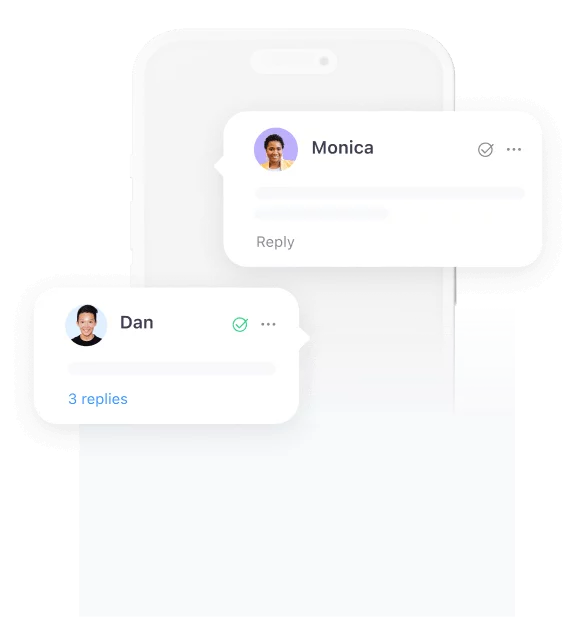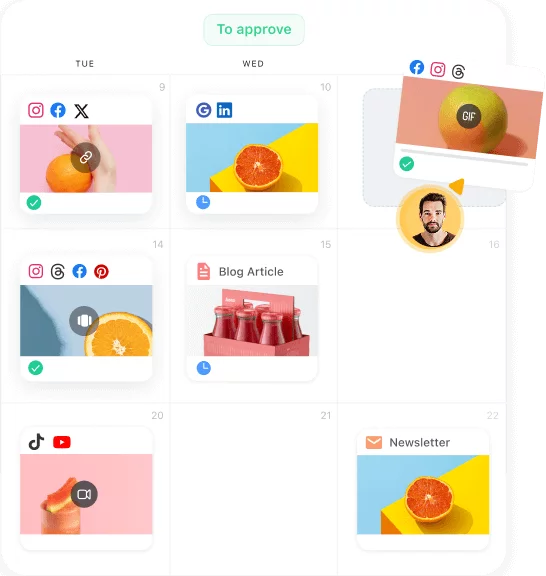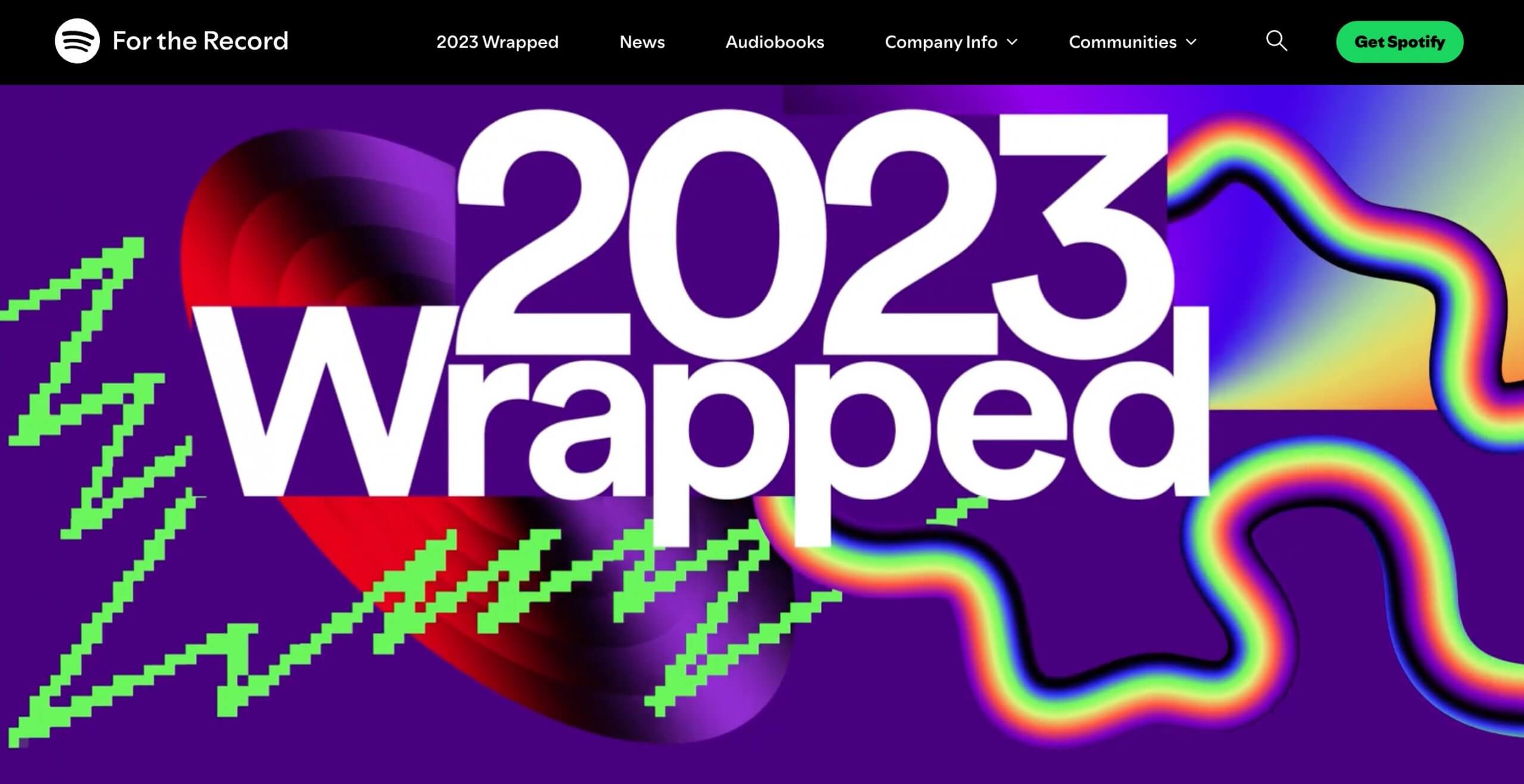As a social media marketer, one of the biggest challenges you must overcome is white noise. Consumers are constantly bombarded with random promotions, alerts, and notifications. You’ll have trouble grabbing your prospects’ attention, much less converting them into customers, unless you pull them away from these distractions.
You need a unique yet proven approach to stand out in saturated, hyper-competitive social media landscapes. Don’t just run random ads online. Generic campaigns geared toward a broad audience will merely spike your ad spend and hurt your return on ad spend (ROAS). More simply put, you’ll lose money on your ads.
Before launching your next campaign, revisit your social media strategy. See what areas you can improve to ensure they hit your target metrics.
At a basic level, social media marketing, i.e., SMM or digital marketing, is any marketing strategy that leverages social networks. Brands typically run campaigns through these platforms:
- Facebook
- X
- Instagram
- Snapchat
- LinkedIn
- YouTube
- TikTok
- WhatsApp
- Messenger
As with other marketing tactics, you must integrate your business goals into SMM. Remember: paid social media advertising don’t guarantee results. A well-planned social media campaign can help, but you must set feasible yet challenging goals for your reach, conversion rates, sales, and impressions—stop funding campaigns that barely meet your targets. Otherwise, you’ll drive up your overhead.
That said, there are several universal metrics that brands follow when executing SMM strategies, including:
- Impressions: Don’t just aim for a high ad view count. Instead, focus on targeting qualified prospects who are most likely to purchase your products or services.
- Traffic: Check how much traffic ads are driving to your website. Ideally, at least 1 to 5 percent of the users who see them should visit the linked landing page.
- Bounce Rate: To get the most out of the result, one has to be wisely organized when starting an e-commerce business. The great UX solutions help to be realistic when tracking how long visitors spend on your site. For example, you have healthy click-through rates but high bounce rates. Then, you might have to make your website more appealing and navigable if the website is inconvenient to use. Alternatively, you might want to review your product descriptions, prices, images, etc. There are two different courses of action. Otherwise, you’ll waste the traffic that your ads generate.
- Engagement: Apart from ad views and clicks, check your comments sections. Read what people say about your brand, analyze the sentiment behind their input, and see how you can incorporate their ideas into your SMM.
- Conversion Rates: Higher site traffic implies better brand awareness, which is great, but you need paying customers to scale operations. Always compare your clicks, views, and impressions with your conversion rates.
- Abandoned Cart Rates: eCommerce shop owners should regularly check their online shopping cart abandonment rates. See how much of your organic and paid traffic end up ditching their orders at the last minute. They’re already at the end of the sales funnel, after all. It’ll take far less effort to convert these cart abandoners than prospects who are seeing your business for the first time.
10 examples of clever Social Media Marketing to copy
Here are some of the most clever SMM campaigns executed by various global brands. Study their approach, analyze the metrics they target, and see how you can integrate them into your own strategies.
1. Samsung’s Galaxy Unpacked Live Stream
The problem with most special presentations and product announcements in the tech industry is their complexity. Merely talking about new features feels unexciting. Consumers who are unfamiliar with your niche won’t even understand the purpose or benefit of these functions. For instance, photography newbies might not appreciate demos on camera specs.
Samsung understands these nuances. And to make the livestream events for the 2023 and 2024 Galaxy Unpacked interesting, it introduced several gaming elements into its virtual landscape. They wanted viewers to test features themselves.
Consequently, Samsung was able to target a broader audience. Apart from repeat customers, its campaign also reached those who use other smartphone brands. The company wanted to show what it did better than its rivals.
2. Spotify Wrapped
Spotify Wrapped is an annual campaign wherein Spotify compiles and analyzes your music streaming habits. The app highlights your preferred genres, artists, and songs. Users can only access this feature for a limited period from November to December, which builds anticipation.
What makes Spotify Wrapped so successful is that it adds fun, unique elements to analyses. Let’s take the 2023 campaign as an example. Apart from a chart of your music preferences, you’ll also see how they translate to your personality type. Of course, its output is by no means backed by scientific research. It’s merely an entertaining feature that lets you visualize and share your music taste with others.
Jim Pendergast, the senior vice president of altLINE Sobanco, says Spotify Wrapped is an excellent strategy to improve both customer retention and acquisition rates. He says, “Spotify Wrapped appeals to both old and new customers. Users from other music streaming platforms might consider switching to Spotify just to try this feature. They probably felt left out after seeing their friends share their results. Likewise, it encourages existing subscribers to keep using Spotify because they need to provide one year’s worth of music streaming data.”
3. Apple’s Shot on iPhone Campaigns
The Shot on iPhone brand campaign highlights the iPhone’s powerful camera specs. By no means are iPhones on par with DSLR cameras, of course, but Apple wants to show that they can hold their own. You can still see the ongoing campaign if you search Shot on iPhone online.
Apple started the campaign with a small contest. Basically, iPhone users could upload their videos and images on social media with the hashtag #ShotoniPhone. The prizes weren’t anything extravagant, but many still participated.
Over time, the Shot on iPhone campaign turned into a massive movement where Apple partners with directors to shoot music videos, promotional videos, and even full-length movies with just an iPhone.
It’s safe to say that the campaign produced amazing results. Most people consider the iPhone’s camera quality the best in the industry—they don’t even care whether rivals like Samsung release more advanced models.
4. Dove’s Real Beauty Sketches
Dove first challenged unrealistic beauty standards when it launched Dove’s Real Beauty Sketches in 2013. The campaign involves artists drawing participants based on how strangers describe them. Understanding the way other people see you shifts your idea of beauty—people tend to focus on their flaws and overlook their strong points.
The campaign generated positive reactions from viewers worldwide. In fact, it was such a massive success that Dove started shifting its branding toward body positivity and acceptance. What’s more is that its rival companies followed suit shortly afterward. Dove is one of the largest beauty brands in the world, so it’s no surprise that it can easily set and control trends.
Apart from body positivity and acceptance, Dove now talks about inclusivity. The company shares how “beauty” has evolved over the years—it no longer confines men and women to societal roles. You can be as beautiful or handsome as you want regardless of your biological sex.
5. Netflix’s Squid Game: The Challenge
The Korean series Squid Game was a major hit. Despite the language barrier, it received several awards from various global institutions. And since the series ended on a cliffhanger, it’s heavily implied that the show will return soon.
However, producing such a massive series requires a lot of resources. They need a lot of time, money, and manpower to meet their audience’s high expectations—rushing the process will only yield subpar results. The only problem is they also can’t dillydally; otherwise, people would lose interest.
To maintain engagement, the production studios behind Squid Game recently released a reality show based on the series. The contestants won’t fight to the death, of course. But they’ll be recreating most of the games played in the actual Squid Game show, plus there’s also a large cash prize involved.
Unsurprisingly, the producers achieved their goal. While the reality show was gaining attention, Netflix suddenly released a trailer for season 2 of Squid Game.
Tip: Time management is critical when executing multi-step projects like movie production. Even minor slip-ups could cause bottlenecks. To ensure your plans go smoothly, ensure you spot and correct the most common mistakes you commit when organizing your timesheets.
6. Lego’s Hidden Side Augmented Reality (AR) Experience
Lego launched an AR version of its Lego sets. Once you join the Lego Insider’s Club, you can create virtual versions of Lego sets, play themed games, and create custom characters. It’s an accessible, sustainable way to test Lego sets before buying them. After all, Lego sets are pricey—spending over $100 on toys your kids will rarely play with isn’t a wise choice.
The site is still running, and anyone can sign up for an account. It’s an excellent way for Lego to engage with new and existing customers alike. Prospects who’ve never played with Lego sets can learn more about them; meanwhile, existing customers can join the Insider’s Club to unlock exclusive features.
Tip: If you want to adopt the same marketing strategy, consider working with the correct professionals. Building an AI microsite is a complex project. Instead of manually learning to develop web pages, either hire professional web design service providers or develop a SaaS-powered product. Spend your time on projects that are up your alley.
7. Airbnb’s Live There Campaign
The feud between Airbnb and hotels has evolved into a competitive coexistence. Although they target different types of travelers, people can’t help but compare these two entities based on price, amenities, and accessibility. They’re always checking which lodging option is worth the cost.
To set its listings apart from hotels, Airbnb launched the “Don’t Go There, Live There” campaign in 2016. It features stories of how hosts transformed their homes into rental spaces. The campaign’s goal is to encourage travelers to treat listings as their own “homes” instead of the conventional short-term rental rooms.
Consequently, the campaign produced excellent results. Not only did it increase brand awareness, but people were also staying in Airbnb properties for longer periods. Digital nomads even live in them for several months at a time.
Tip: Before starting a rental property business, identify whether you want to target short-term guests or long-term tenants. You’ll have to adjust your business model accordingly.
8. IKEA’s Buy Back Friday Campaign
Most consumers don’t realize how much furniture waste they produce. About 12 million tons of old tables, couches, bed frames, and mattresses, among other pieces, go straight to landfill every year. What’s worse is many aren’t recyclable.
To help address this growing issue, IKEA started the Buy-Back Friday campaign. As the name suggests, it’s a program wherein IKEA buys back second-hand furniture, refurbishes them, and then sells them at a discounted rate. It’s a sustainable, cost-efficient campaign driven by eco-friendly motives.
9. Duolingo’s Tiny Owl Tutor Icon
Duo, the tiny owl icon on the app, is Duolingo’s iconic mascot. Considering its frequent appearances throughout lessons, promotions, and even push notifications, users are very familiar with it.
To further boost Duo’s popularity, Duolingo made a promotional film about it. The animated video shows Duo teaching various languages to children of different ethnic backgrounds. It focuses on inclusivity and diversity.
The promotion was well-received worldwide, and more users learned about the app. What’s more, interested users and prospects became long-term subscribers because of the app’s simplicity. Anyone, from curious children to working adults, can use Duolingo.
You can adopt the same strategy if you already have a brand icon. Start by increasing brand awareness and familiarity—use your icon or logo in every ad or campaign you launch. Once more people know about it, you can begin highlighting it in your promotions. Admittedly, producing short films is expensive, but you can minimize your expenses by creating comics, promotional ads, or social posts instead.
10. M&M’s can’t stop the Wonka campaign
M&M Can’t Stop the Wonka Campaign is an interactive AR experience that spikes audience interest through intriguing storylines and gamified ads. M&M kickstarted the campaign in January 2023 by “removing” its spokescandies. The company said it would change its name to Ma&Ya in honor of Maya Rudolph, its new representative and ambassador. It even changed its name across all social platforms.
Most consumers knew this campaign was an obvious stunt—those who weren’t fond of Maya even felt annoyed. Regardless of perception, however, it got people talking. M&M continued to create buzz around their brand and spike audience interest until their final ad at the 2023 Super Bowl. It’s a silly video showcasing the return of M&M’s spokescandies. Apparently, the company’s shift to Ma&Ya was a hostile takeover where Maya’s character took the spokescandies hostage. Of course, the original spokescandies eventually “kicked” Maya out of the company.
To further brand engagement, M&M launched a follow-up campaign wherein buyers could tour its factories if they collected enough virtual candies. It leveraged the spike in brand awareness to drive engagement.
Make better Social Media Marketing Campaigns for your brand
Only take inspiration from these SMM tactics. Although they worked well for other brands, there’s no guarantee that you can recreate the exact results. Base your SMM approach on industry-relevant metrics that align with your unique business goals.
That said, we also understand that running a business can be very hectic—you might not have much time for SMM planning. To streamline the process, equip your marketing team with the correct tools. We suggest exploring all-around platforms like Planable. They can automate routine tasks, schedule content ahead of time, pull real-time ad analytics, and track tasks within your team. Sign up for a free trial!
Jesse is a professional writer whose aim is to make complex concepts easy to understand. He strives to provide quality content that assists people in everyday life.








